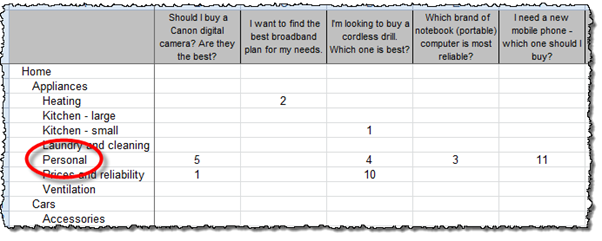...
Usability guru Jared Spool has written extensively about the ~“scent scent of information”information – how users hunt through a site, click by click, to find the content they’re looking for. Tree testing helps you deliver a strong scent by improving organisation :
- organization (how you group your headings and subheadings), and
...
- labeling (what you call each of them).
Anyone who’s watched a spy film knows that there are always false scents and red herrings to lead the hero astray. Anyone who’s run a few tree tests has probably seen the same thing – headings that lure participants to the wrong answer. We call these “evil attractors”“evil attractors”. These are headings that lure participants down the wrong path – not just for one task, but for several different tasks.
...
We ran the tests and got some useful answers, but we also noticed that there was one particular subheading (Home > Appliances > Personal) that got clicks from participants looking for very different things – mobile phones, vacuum cleaners, home-theatre theater systems, and so on:
The website intended this “personal appliance” category to be for products like electric shavers and curling irons, but apparently “Personal” meant many things to our participants, because they also went there for “personal” items like mobiles and cordless drills that actually lived somewhere else.
...
In the consumer-site example, we looked at the actual content under the “Personal” heading. It turned out to be items like shavers, curling irons, and hair dryers. A quick discussion yielded “Personal care” as a promising replacement – one that should keep away people looking for mobile phones and jewellery jewelery and the like.
In the second round of tree testing, among the other changes we made to the tree, we replaced “Personal” with “Personal care”. A few days later, the results confirmed our thinking – our former evil attractor was no longer luring participants away from the correct answers:
...
- Top-level headings are usually easy to check for evil attractors, if the tool you’re using has a way of highlighting “first clicks”. If you see a level-1 topic getting lots of incorrect clicks across several tasks, chances are that it’s an evil attractor.
A very common culprit is an “other stuff” heading like “Resources” Resources. It’s so general that it will get all kinds of traffic for all kinds of reasons. - Mid-level headings typically need a bit more detective work to see if they’re evil attractors. Usually this means eyeballing all your task results to see if certain mid-level topics are luring clicks when they shouldn’t. For more, see Where they went earlier in this chapter.
- ~need more on this
...
